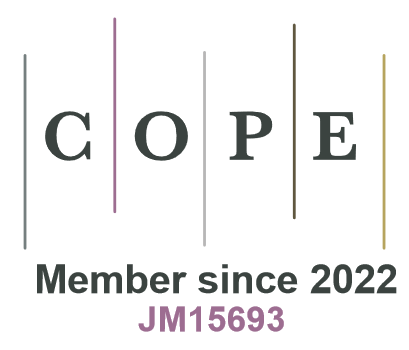Revealing burden of elevated blood pressure among Polish adolescent participants in a population-based ADOPOLNOR study: prevalence and potent risk factors
DOI:
https://doi.org/10.2478/anre-2019-0005Keywords:
adolescents, elevated BP, sex, age, BMI, odds ratioAbstract
New category for elevated blood pressure introduced and described by JNC-7 for adults and adopted by the 2004 Working Group for children and adolescents stands for a pre-sign to hypertension. The ongoing rise in prevalence of high blood pressure in children and adolescents demands their regular screening. The objective of this study was to determine prevalence of elevated BP in Polish adolescents and explain the role of sex, age and body weight status as potent risk factors for this condition. A population-based cross-sectional survey was carried out on a sample of 4,941 students (2,451 boys and 2,490 girls) aged 10–18, participants in the ADOPOLNOR study. Body height and weight were measured and BMI was calculated. Blood pressure was measured twice on each visit on the right arm using a fully calibrated TECH MED TM-Z mercury gauge sphygmomanometer with sets of exchangeable cuffs and a clinical stethoscope. The blood pressure classification was determined using the surveillance method. The depended outcome variable was the elevated BP compared to normal BP for systolic (SBP), diastolic (DBP) and combined SBP and/or DBP. Explanatory variables included demographic characteristics, sex and age, and weight status. Two-way ANCOVA, Chi-square Pearson correlation, and multivariate logistic regression analysis (MLRA) were performed using the STATISTICA 13.1 data analysis software system; p-value <0.05 was considered statistically significant (StatSoft Inc. Tulsa, OK, USA). A clear gender pattern was found in prevalence of elevated BP with girls being more likely than boys to have elevated BP (4.9%, 5.3% and 7.4% for SBP, DBP and combined SBP and/or DBP in girls vs 3.5%, 3.5% and 5.9% in boys). The proportion of both genders with elevated BP gradually increased with age with 4.8% (SBP), 2.8% (DBP) and 5.8% (SBP and/or DBP), and 5.1%, 6.4% and 8.4% in early and late adolescence, respectively. Fifteen percent of obese adolescents had elevated SBP, 14.3% elevated DBP and 17.8% had elevated either SBP and/or DBP combined. At multivariate approach, the adjusted odds ratio for predictors of elevated BP revealed sex, age and weight status for SBP and SBP and/or DPB combined. Age and weight status were predictive for elevated DBP. Weight status (BMI) showed the highest predictive potential of elevated BP for both genders. The likelihood of developing elevated BP increased at least twice with each BMI category increase. Thus, overweight and obese adolescents were twice (overweight) and 4 to 5 times (obese) more likely than their normal weight counterparts in developing elevated BP. The study results confirmed predictive potential of sex, age, and weight status in developing elevated BP in adolescents. The highest odds of the weight status indicate that it is the strongest confounder of elevated BP condition.
Downloads
References
Acosta AA, Samuels JA, Portman RJ, Redwine KM. 2011. Prevalence of persistent prehypertension in adolescents. J Pediatr Dec 6.2011 e-pub (Accessed: December 15, 2018).
View in Google Scholar
Adams HR, Szilagyi PG, Gebhardt L, Lande MB (2010) Learning and attention problems among children with pediatric primary hypertension. Pediatrics 126(6):e1425–29.
View in Google Scholar
Au CT, Ho CK, Wing YK, Lam HS, Li AM. 2014. Acute and chronic effects of sleep duration on blood pressure. Pediatrics 133(1). Available at www.pediatrics.org/cgi/content/full/133/1/e64 (Accessed: December 15, 2018).
View in Google Scholar
Bayrakci US, Schaefer F, Duzova A, Yigit S, Bakkaloglu A. 2007. Abnormal circadian blood pressure regulation in children born preterm. J Pediatr 151(4):399–403.
View in Google Scholar
Cameron N, Bogin B. (eds.) 2012. Human Growth and Development, ed. 2. New York: Elsevier.
View in Google Scholar
Chen E, Matthews KA, Boyce WT. 2002. Socioeconomic differences in children’s health: how and why do these relationships change with age? Psychol Bull 128(2):295–329.
View in Google Scholar
Chen X, Wang Y. 2008. Tracking of blood pressure from childhood to adulthood: a systematic review and meta-regression analysis. Circulation 117:3171–80.
View in Google Scholar
Chiolero A, Cachat F, Burnier M, Paccaud F, Bovet P. 2007. Prevalence of hypertension in schoolchildren based on repeated measurements and association with overweight. J Hypertens 25(11):2209–17.
View in Google Scholar
Chobanian AV, Bakris GL, Black HR, et al. (2003) The seventh report of the Joint National Committee on Prevention, Detection, Evaluation, and Treatment of High Blood Pressure: the JNC 7 report. JAMA 289:2560–72.
View in Google Scholar
Cole TJ, Bellizzi MC, Flegal KM, Dietz WH . 2000. Establishing a standard definition for child overweight and obesity worldwide: international survey. Brit Med J 320:1240–3.
View in Google Scholar
Cole TJ, Flegal KM, Nicholls D, Jackson AA. 2007. Body mass index cut offs to define thinness in children and adolescents: international survey. Brit Med J 335:194–201.
View in Google Scholar
Danaei G, Mariel M, Finucane MM et al. on behalf of the Global Burden of Metabolic Risk Factors of Chronic Diseases Collaborating Group (Blood Pressure). 2011. National, regional, and global trends in systolic blood pressure since 1980: systematic analysis of health examination surveys and epidemiological studies with 786 country-years and 5·million participants. Lancet, 377: 568–77.
View in Google Scholar
Dasgupta K, O’Loughlin J, Chen S, Karp I, Paradis G, Tremblay J, et al. 2006. Emergence of sex differences in prevalence of high systolic blood pressure: analysis of a longitudinal adolescent cohort. Circulation 114(24):2663–70.
View in Google Scholar
de Moraes ACF, Lacerda MB, Moreno LA, Horta BL, Carvalho HB. 2014. Prevalence of high blood pressure in 122,053 adolescents: a systematic review and meta-regression. Medicine 93(27):p e232
View in Google Scholar
Din-Dzietham R, Liu Y, Bielo MV, Shamsa F. 2007. High blood pressure trends in children and adolescents in national surveys, 1963 to 2002. Circulation 116(13):1488–96.
View in Google Scholar
Edvardsson VO, Steinthorsdottir SD, Eliasdottir SB, Indridason OS, Palsson R. 2012. Birth weight and childhood blood pressure. Curr Hypertens Rep 14(6):596–602.
View in Google Scholar
Fairclough SJ, Boddy LM, Hackett AF, Stratton G. 2009. Associations between children’s socioeconomic status, weight status, and sex, with screen based sedentary behaviours and sport participation. Int J Pediatr Obes 4:299–305.
View in Google Scholar
Falkner B. 2010. Hypertension in children and adolescents: epidemiology and natural history. Pediatr Nephrol 25:1219–24.
View in Google Scholar
Flynn JT, Kaelber DC, Baker-Smith CM, Blowey D, Caroll AE, Daniels SR et al. and SUBCOMMITTEE ON SCREENING AND MANAGEMENT OF HIGH BLOOD PRESSURE IN CHILDREN. 2017. Clinical Practice Guideline for Screening and Management of High Blood Pressure in Children and Adolescents. Pediatrics 140.
View in Google Scholar
Friedemann C, Heneghan C, Mahtani K, Thompson M, Perera R, Ward AM. 2012. Cardiovascular disease risk in healthy children and its association with body mass index: systematic review and meta-analysis. BMJ 345:e4759.
View in Google Scholar
Hansen ML, Gunn PW, Kaelber DC. 2007. Underdiagnosis of hypertension in children and adolescents. JAMA 298(8):874–9.
View in Google Scholar
Kaczmarek M. 2011. Conceptual frameworks and methodological tools for multidisciplinary approach to the adolescent health research In: Kaczmarek M. (ed.) Health and Well – Being in Adolescence. Part one Physical Health and Subjective Well-Being. Bogucki Wydawnictwo Naukowe, Poznań:19–43.
View in Google Scholar
Kaczmarek M, Stawińska-Witoszyńska B, Krzyżaniak A, Krzywińska-Wiewiorowska M, Siwińska A. 2015. Who is at higher risk of hypertension? Socioeconomic status differences in blood pressure among Polish adolescents: a population-based ADOPOLNOR study. Eur J Ped 174(11):1461–73.
View in Google Scholar
Kardas P, Kufelnicka M, Herczynski D. 2005. Prevalence of arterial hypertension in children aged 9–14 years, residents of the city of Lodz. Kardiol Pol 62:211–6.
View in Google Scholar
Kit BK, Kuklina E, Carroll MD, Ostchega Y, Freedman DS, Ogden CL. 2015. Prevalence of and trends in dyslipidemia and blood pressure among US children and adolescents, 1999–2012. JAMA Pediatr 169(3):272–9.
View in Google Scholar
Knussmann, R. 1988/1992) Anthropologie, Handbuch der vergleichenden Biologie des Menschen, Band 1. Fischer Verlag, Stuttgart pp 232–285.
View in Google Scholar
Krzyżaniak A, Stawińska-Witoszyńska B, Szilágyi-Pągowska I, Palczewska I . 2003. Ciśnienie tętnicze dzieci i młodzieży województwa mazowieckiego i wielkopolskiego. Przegląd Lekarski 60(supl. 6):81–5.
View in Google Scholar
Krzyżaniak A, Krzywińska-Wiewiorowska M, Stawińska-Witoszyńska B, Kaczmarek M, Krzych Ł, Kowalska M, et. al. 2009. Blood pressure references for Polish children and adolescents. Eur J Ped 168:1335–42.
View in Google Scholar
Kułaga Z, Litwin M, Zajączkowska M, Wasilewska A, Tkaczyk M, Gurzkowska B, Świąder A et al. 2009. Regionalne różnice parametrów antropometrycznych oraz ciśnienia tętniczego uczniów w wieku 7–18 lat. Probl Hig Epidemiol 90(1):32–41.
View in Google Scholar
Kułaga Z, Litwin M, Tkaczyk M, Pan H et al. 2010. Polish 2010 growth references for school-aged children and adolescents. Eur J Ped 170(5):599–609.
View in Google Scholar
Kułaga Z, Litwin M, Grajda A, Kułaga K, Gurzkowska B, Góźdź M, Pan H et al. 2012. Oscillometric blood pressure percentiles for Polish normal-weight school-aged children and adolescents. J. Hypertens 30(10):1942–54.
View in Google Scholar
Mann CJ. 2003. Observational research methods. Research design II: cohort, cross-sectional, and case-control studies. Emerg Med J 20:54–60
View in Google Scholar
May AL, Kuklina EV, Yoon PW. 2012. Prevalence of cardiovascular disease risk factors among US adolescents, 1999–2008. Pediatrics 129(6):1035–41.
View in Google Scholar
McNiece KL, Poffenbarger TS, Turner JL, Franco KD, Sorof JM, Portman RJ. 2007. Prevalence of hypertension and prehypertension among adolescents. J Pediatr 150(6):640–4.e1
View in Google Scholar
National Heart L, and Blood Institute. 1977. Report of the Task force on Blood Pressure Control in Children. Pediatrics 59:797–820.
View in Google Scholar
National High Blood Pressure Education Program Working Group on High Blood Pressure in Children and Adolescents. The fourth report on the diagnosis, evaluation, and treatment of high blood pressure in children and adolescents. 2004. Pediatrics 114(2, suppl 4th Report):555–76.
View in Google Scholar
Ostrowska-Nawarycz L, Nawarycz T. 2007. Prevalence of excessive body weight and high blood pressure in children and adolescents in the city of Łódź. Kardiol Pol 65:1079–87.
View in Google Scholar
Rosner B, Cook NR, Daniels S, Falkner B. 2013. Childhood blood pressure trends and risk factors for high blood pressure: the NHANES experience 1988–2008. Hypertension 62(2):247–54.
View in Google Scholar
Salvadori M, Sontrop JM, Garg AX, Truong J, Suri RS, Mahmud FH, Macnab JJ, Clark WF. 2008. Elevated blood pressure in relation to overweight and obesity among children in a rural Canadian community. Pediatrics 122:e821–e827.
View in Google Scholar
Shi Y, de Groh M, Morrison H. 2012. Increasing blood pressure and its associated factors in Canadian children and adolescents from the Canadian Health Measures Survey. BMC Public Health 12:388.
View in Google Scholar
Silva DA, de Lima LR, Dellagrana RA, Bacil ED, Rech CR. 2013. High blood pressure in adolescents: prevalence and associated factors. Cien Saude Colet 18(11):3391–3400.
View in Google Scholar
Skinner AC, Perrin EM, Moss LA, Skelton JA. 2015. Cardiometabolic risks and severity of obesity in children and young adults. N Engl J Med 373(14):1307–17.
View in Google Scholar
Stein DJ, Scott K, Haro Abad JM, et al. 2010. Early childhood adversity and later hypertension: data from the World Mental Health Survey. Ann Clin Psychiatry 22(1):19–28.
View in Google Scholar
Sun SS, Grave GD, Siervogel RM, Pickoff AA, Arslanian SS, Daniels SR. 2007. Systolic blood pressure in childhood predicts hypertension and metabolic syndrome later in life. Pediatrics 119(2):237–46.
View in Google Scholar
Theodore RF, Broadbent J, Nagin D, et al. 2015. Childhood to early-midlife systolic blood pressure trajectories: early-life predictors, effect modifiers, and adult cardiovascular outcomes. Hypertension. 66(6):1108–115.
View in Google Scholar
Urbina EM, Khoury PR, McCoy C, Daniels SR, Kimball TR, Dolan LM. 2011. Cardiac and vascular consequences of pre-hypertension in youth. J Clin Hypertens (Greenwich) 13(5):332–42.
View in Google Scholar
van Dijk AE, van Eijsden M, Stronks K, Gemke RJ, Vrijkotte TG. 2012. The association between prenatal psychosocial stress and blood pressure in the child at age 5–7 years. PLoS One 7(8):e43548.
View in Google Scholar
Wang X, Poole JC, Treiber FA, Harshfield GA, Hanevold CD, Snieder H. 2006. Ethnic and gender differences in ambulatory blood pressure trajectories: results from a 15-year longitudinal study in youth and young adults. Circulation 114(25):2780–7.
View in Google Scholar
Willi SM, Hirst K, Jago R, et al; HEALTHY Study Group. 2012. Cardiovascular risk factors in multi-ethnic middle school students: the HEALTHY primary prevention trial. Pediatr Obes 7(3):230–39.
View in Google Scholar
World Medical Association Declaration of Helsinki. Ethical principles for medical research involving human subjects. 2001. Bulletin of World Health Organisation, 79(4): 373–4.
View in Google Scholar
Downloads
Published
How to Cite
Issue
Section
License

This work is licensed under a Creative Commons Attribution-NonCommercial-NoDerivatives 4.0 International License.








